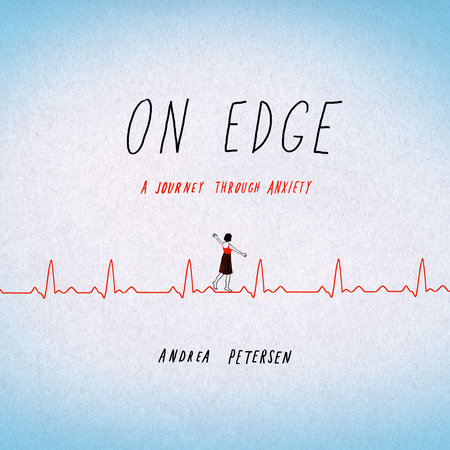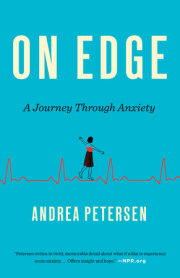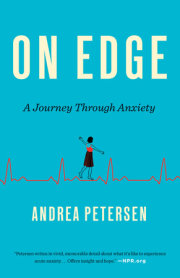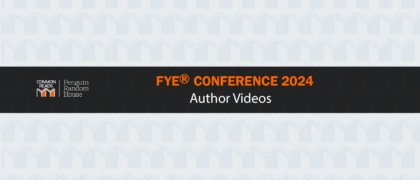1
The Anticipation of Pain
Defining Anxiety
Eleven different anxiety disorders are listed in the fifth edition of the Diagnostic and Statistical Manual of Mental Disorders, commonly referred to as the diagnostic bible. I had symptoms of four. I was having panic attacks--sudden, intense periods of blinding terror, rapid breathing, and chest pain--several times a day (diagnosis: panic disorder). The rest of the time I worried, living with the nervous expectation of imminent disaster (diagnosis: generalized anxiety disorder, or GAD). I had developed a long list of particular fears, too: dentists, flying, driving on highways, taking medication, touching dirt, using a new tube of toothpaste, and licking envelopes. I did my best to avoid them all (diagnosis: specific phobia). My world was becoming smaller and smaller as more places became no‑go zones: movie theaters, stadiums, lines. The potential for panic attacks--and the difficulty of escape--was too great (diagnosis: agoraphobia).
I had symptoms of a couple of cousin disorders, too. A twisted perfectionism turned the smallest decision into a colossal obstacle; I felt a sense of sinister foreboding if I didn’t choose the “right” dress to wear, the “right” water glass (diagnosis: obsessive-compulsive disorder). I agonized over every odd sensation or twinge of physical pain. A headache was clearly an aneurysm; a bruise, leukemia (diagnosis: illness anxiety disorder, previously called hypochondriasis).
The estimated number of people who will have at least one anxiety disorder during the course of their lives is staggering: one in three Americans ages thirteen or older. If we look only at women, the number is even higher--more than 40 percent. In any given year, about 40 million American adults have an anxiety disorder. And those numbers do not include the millions of garden-variety worriers and insomniacs whose anxiety, though not debilitating, leaches joy and steals peace of mind.
A certain amount of anxiety is good. It motivates us to study for tests, prepare for presentations, and save for retirement. It spurs us to get a physical or check the gas gauge. Too much anxiety, however, can be incapacitating and costly. In 1998, the most recent year for which figures are available, anxiety disorders cost the United States about $63 billion, more than half of it attributed to doctor and hospital visits. Other costs included psychiatric treatment, prescription drugs, and the value of lost productivity at work. There’s also mounting evidence that out-of-control anxiety wreaks havoc on the body, increasing the risk of heart disease and suppressing the immune system. Ironically, being a hypochondriac may actually make you sick.
It is tempting to think of our era--with its wars, terrorist attacks, rising sea levels, and economic insecurity--as, to borrow the poet W. H. Auden’s phrase, “the age of anxiety.” But cultural commentators throughout history have viewed their own times as equally fraught. In the 1880s, the telegraph, the steam engine, and even women’s intellectual pursuits were blamed for the nation’s unease. In the 1950s, it was the atomic bomb. Our world, it seems, always provides ample fodder for fear.
What is disconcerting is that rates of anxiety disorders--and depression--seem to be increasing among young people, particularly college students. According to a spring 2016 survey by the American College Health Association, about 17 percent of students were diagnosed with or treated for anxiety problems during the previous year, and nearly 14 percent were diagnosed with or treated for depression. That is up from about 10 percent each for anxiety and depression in the fall 2008 survey. Parents and professionals are perplexed. While some of the rise may be because of increased prevalence, it could also be that more people are comfortable asking for help and admitting their troubles to researchers.
Depression may get most of the headlines and the research dollars, but anxiety is more prevalent. In people with a history of both an anxiety and a mood disorder, anxiety usually makes an appearance first. Anxiety disorders strike young, too: They have a median age of onset of fifteen, compared with twenty-six for mood disorders. And while anxiety disorders are pretty miserable in and of themselves, they are increasingly being thought of as gateway illnesses that can lead to a host of other problems, such as depression, substance use, and even suicide.
In fact, anxiety can be deadly. Depression is the mental illness most strongly associated with suicidal thoughts, but it doesn’t often lead to suicidal acts. Recent research has found that it is anxiety disorders and other illnesses, like problems with impulse control and addiction, that are more likely to lead to suicide attempts.
In most cases, the consequences aren’t fatal. Still, anxiety disorders can derail lives. Someone who develops an anxiety disorder at a young age is less likely to attend college. Anxious people who work have lower incomes. They are less likely to marry and, if they do, more likely to divorce. Anxious women face a greater risk of getting into unhealthy relationships and being the victim of domestic abuse.
That, thankfully, is not my story. If you met me now, you probably wouldn’t even notice my anxiety. (When I began telling acquaintances the topic of this book, they almost uniformly said, “I would never have guessed you’re anxious.”) I have a career I love, as a reporter writing stories for the Wall Street Journal. I’m happily married, with an adorable seven-year-old daughter. I have friends, laugh a lot, go to parties, and bake pies. My affliction is often invisible.
I have had many advantages. I grew up in a loving home, lived in safe neighborhoods, and went to good schools. I have almost always had health insurance and the ability to pay for therapy and medication. While these privileges didn’t prevent me from falling apart, I know they were critical in putting me back together.
But it has been a struggle. In tough years, I take medication and cycle through new therapies. In easy years, I still have to be diligent: Sleep eight hours. Do yoga. Take it easy on the wine. Pare down my responsibilities. And still I grapple with worry-induced insomnia. I tend to procrastinate, terrified of making the wrong choices. I have odd, unexplained physical symptoms--a tingling arm, chest pain. I can’t drive on highways. Anxiety affects how I work, how I love, and how I parent.
So what is anxiety?
The DSM calls it “anticipation of future threat.” Søren Kierkegaard, the nineteenth-century Danish philosopher, called it “the dizziness of freedom.” But the most cogent definition I’ve heard comes from Christian Grillon, a neuroscientist at the National Institute of Mental Health (NIMH). “Anxiety is the anticipation of pain,” he told me. “It could be physical pain or emotional pain.”
Anxiety is related to fear but is distinct. Whereas fear is concrete and imminent, anxiety is, as Grillon says, “sustained uncertainty.” It’s a chronic sense of uneasiness about a vague future, a gnawing worry about what may or may not happen.
Anxiety is universal, but the language we use to talk about it varies by culture, and so do its symptoms. The word anxiety comes from the Latin angere, which means “to choke or throttle.” In Cambodia, khyal (“wind”) attacks involve neck pain, dizziness, and ringing in the ears. In Vietnam, trung gio (“wind-related”) attacks are characterized by headaches. In Latin America, ataques de nervios (“attacks of nerves”) can include uncontrollable screaming and crying.
Differing cultural perceptions of anxiety make it difficult to accurately compare rates of anxiety disorders in countries around the world. Yes, studies show that, in Japan, only about 4 percent of the population has an anxiety disorder in a given year, and that the French have a rate (13.7 percent) more than double that of the Spanish (6.6 percent). But these statistics are influenced by everything from how researchers define the word worry to who responds to surveys. (You could argue that the most anxious people are the least likely to answer a stranger’s probing questions.)
Anxiety also exists on a continuum. There is no sharp boundary between mental health and mental illness, and no doubt other cultures draw the boundary differently than we do. When I asked Ron Kessler of Harvard Medical School, the country’s leading mental health epidemiologist, why so many people have anxiety problems, he said it was because “we have decided it is a disorder.” Still, even if we have become alert to the idea that everyday anxieties can be symptoms of a disorder, a formal psychiatric diagnosis requires that the person suffer from “clinically significant distress or impairment” in functioning. No matter the symptoms or the name you give it, anxiety is a problem if it keeps you from living--and enjoying--your life the way you want to.
I’ve tangled with severe anxiety for more than twenty-five years. Looking back, my troubles didn’t actually begin that December day in college, though it wasn’t until then that it spiraled out of control. I had been having strange “spells” for months. They started when I was living at home the summer after my freshman year. During the day, I was working as a receptionist at a company that made steel forgings, the kind of place where the women were called by their first names while the men were all Mister So-and‑so. At night, I waitressed at an Irish bar in East Lansing, where I checked fake IDs, dodged the advances of horny Michigan State guys, and learned to perfect the head on a pint of Miller Light. Between jobs, I took step aerobics classes.
One night I was at the apartment of my boyfriend, Scott, a Michigan State student and Christopher Reeve doppelgänger I had begun dating in high school. The evening’s goal was, to paraphrase him, to get me high. I had tried smoking pot once or twice before but very tentatively. (I, seriously, tried not to inhale.) Frankly, I was afraid of it. I had been around enough of the stuff when I was a kid at my parents’ and my friends’ parents’ parties, the blue sheen of bongs glinting off Pledge-buffed coffee tables. Pot always seemed to make people silly and stupid. But Scott, an enthusiastic stoner, had been touting its effects for month. I was in.
We started smoking a joint and waited.
Nothing.
“Take another hit,” Scott said.
I did. And when Scott took one, he grabbed me and kissed me, blowing smoke into my mouth.
Several more minutes went by.
Then it hit me.
My heart beat faster. My mouth went dry. I felt breathless. My equilibrium and vision contorted; it was as if I were on a roller coaster the moment before the big plummet. I lay down on Scott’s bed, trying to take deep breaths and calm down. My legs felt like they were stretching, Alice in Wonderland style. I looked down and could have sworn I saw my feet on the other side of the room.
Desperate for distraction and wanting to feel grounded in some way, I reached for Scott and we started having sex. But I could barely feel him. My body was numb, deadened. I panicked.
“I can’t breathe,” I cried, sitting bolt upright.
“Sure you can,” Scott said, taking my hand. “Just relax.”
“I can’t. And my heart is beating so fast, too fast,” I said. “Something must have been in that pot. It must have been laced with something.”
I darted around the room, pacing and gulping air. “Or maybe I’m having an allergic reaction. Something is really wrong. I think I need to go to a hospital.” I threw on sandals, a T‑shirt, and a pair of Scott’s boxer shorts. He scrambled to get dressed, too. I was already turning the doorknob to leave. Scott grabbed his car keys and followed.
At the ER, the bright lights, shiny linoleum, and bureaucratic questions sobered me up fairly quickly. I was not the only college student whose visit was spurred by chemical overindulgence. One drunken kid threw up on the waiting room floor. Another sobbed incoherently. In the exam room, a technician hooked me up to a heart monitor. A few hours later I was told I could go. A doctor scribbled my discharge instructions: “Avoid THC,” he wrote of the active chemical in marijuana.
I did that easily. That one episode was more effective than an entire adolescence of antidrug After School Specials. But the spells of breathlessness, racing heart, and, increasingly, fear, recurred every month or so. They seemed to come from nowhere. I had one while eating fried cheese sticks at Bennigan’s. I had another in the middle of a women’s studies class. I feigned a bathroom emergency and spent the rest of the class crouched in a ladies’ room stall. The attacks subsided after twenty or thirty minutes but left me jelly-legged and shaky for hours.
I don’t remember thinking much about the episodes during the intervals between them. I brushed them off, telling no one but Scott and hoping they’d vanish as abruptly as they’d begun.
1. the anticipation of pain
6 estimated number of people: Ronald C. Kessler et al., “Twelve-Month and Lifetime Prevalence and Lifetime Morbid Risk of Anxiety and Mood Disorders in the United States,” International Journal of Methods in Psychiatric Research 21, no. 3 (2012): 169–84.
6 about 40 million American adults: “Facts and Statistics,” Anxiety and Depression Association of America, https://www.adaa.org/about-adaa/press-room/facts-statistics.
6 anxiety disorders cost the United States: Paul E. Greenberg, “The Economic Burden of Anxiety Disorders in the 1990s,” Journal of Clinical Psychiatry 60, no. 7 (1999): 427–35.
7 According to a spring 2016 survey: American College Health Association National College Health Assessment, Spring 2016 Reference Group Executive Summary (American College Health Association, 2016).
7 up from about 10 percent: American College Health Association National College Health Assessment, Fall 2008 Reference Group Executive Summary (American College Health Association, 2008).
7 Depression may get most of the headlines: In 2015 the National Institutes of Health spent $156 million for research on anxiety disorders and $390 million on depression. Estimates of Funding for Various Research, Condition, and Disease Categories, National Institutes of Health, https://report.nih.gov/categorical_spending.aspx.
7 In people with a history: Ronald C. Kessler, “The Global Burden of Anxiety and Mood Disorders: Putting ESEMeD Findings into Perspective,” Journal of Clinical Psychiatry 68, suppl. 2 (2007): 10–19.
7 doesn’t often lead to suicidal acts: Matthew K. Nock et al., “Mental Disorders, Comorbidity and Suicidal Behavior: Results from the National Comorbidity Survey Replication,” Molecular Psychiatry 15, no. 8 (2010): 868–76.
7 Someone who develops an anxiety disorder: Ronald C. Kessler, Harvard Medical School, interview by author.
8 “the dizziness of freedom”: Søren Kierkegaard, The Concept of Anxiety (Princeton, NJ: Princeton University Press, 1980), 61.
8 varies by culture: American Psychiatric Association, Diagnostic and Statistical Manual of Mental Disorders, 5th ed. (Washington, DC: American Psychiatric Publishing, 2013). Cited hereinafter as DSM‑5.
9 studies show that, in Japan: Ronald C. Kessler et al., “The Global Burden of Mental Disorders: An Update from the WHO World Mental Health (WMH) Surveys,” Epidemiologia e psichiatria sociale 18, no. 1 (2009): 23–33.
Copyright © 2017 by Andrea Petersen. All rights reserved. No part of this excerpt may be reproduced or reprinted without permission in writing from the publisher.







